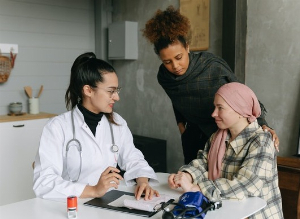Chemotherapy: Everything you need to know!
Published 22 Aug 2021 • By Aurélien De Biagi
Cancer causes more than one in four of all deaths in the UK, according to Cancer Research UK. In 2018, nearly 18.1 million people worldwide were diagnosed with cancer and 9.8 million died from it.
Various treatment options exist for cancer, but in this article, we will focus on chemotherapy.
So, what is chemotherapy? What are its side effects?
We tell you everything in our article!

What is cancer?
Cancer is defined as the uncontrolled growth of certain cells in the body. It begins when a first cancer cell loses its sensitivity to apoptosis (programmed cell death), repairs its DNA less well and no longer controls the replication process. Unable to die and replicating endlessly, a proliferation of cancer cells forms a tumour, which continues to grow.
This abnormal cell proliferation starts locally and then spreads to neighbouring tissues and other organs (metastasis). Metastasis refers to cancer cells that have migrated to another organ. For example, prostate cancer with lung metastasis means that prostate cancer cells have migrated into the lung.
In addition, the term "cancer" is used to describe a large number of heterogeneous diseases. For example, "sarcoma" is used for cancers that develop from supporting cells in the body, "lymphoma" for cancers that originate from lymphatic cells, etc.
At present, there are three possible treatment options for treating cancer: radiotherapy, chemotherapy and surgery. Surgery is still the most successful option, but all three therapies can be used together as combination therapy.
What is chemotherapy?
Chemotherapy or "chemo" refers to the use of chemical molecules (drugs) to treat cancer. There are many different drugs that are used, which are often specific to each cancer. These drugs aim to destroy all cancer cells, regardless of their location. This is called systemic therapy.
Depending on the class of drug used, chemotherapy aims either to destroy the cancer cells or to inhibit their replication. Very often, chemotherapy sessions are combination therapy, i.e., they are composed of several different molecules. The choice of molecule is adapted to each patient, depending on the type and stage of cancer, the location of the tumour, the patient's general state of health, etc.
There are also several types of chemotherapy, which include:
- Neoadjuvant chemotherapy, which is administered as soon as the cancer is diagnosed, before any surgical intervention. Its main objective is to reduce the size of the tumour, but it also allows the effectiveness of the treatment to be assessed and the risk of recurrence to be reduced.
- Adjuvant chemotherapy, which is administered after an initial treatment such as surgery to eliminate any remaining cancer cells. It also reduces the risk of recurrence and metastasis.
- Metastatic chemotherapy, which aims to treat cancer metastasis.
Chemotherapy can also be combined with radiotherapy, in which case it is called chemoradiotherapy, or used alone, in which case it is called exclusive chemotherapy.
What are the side effects of chemotherapy?
The molecules used in chemotherapy are very aggressive and non-specific to cancer cells. As cancer cells are characterised by rapid replication, chemotherapy targets rapidly replicating cells, including healthy cells (hair, digestive tract, reproductive and bone marrow cells). Chemotherapy drugs can therefore cause negative side effects, regardless of the form of administration: oral (capsules, tablets, etc.), intravenous, etc.
Although certain side effects are frequent, this does not mean that they are systematic. Moreover, the effectiveness of the treatment does not depend on the side effects. Chemotherapy can be effective and have no side effects. Conversely, the therapy also may not work and give undesirable effects. The latter depends on the molecules used, the dose, the patient's general condition and the individual's reaction to the treatment.
The most common side effects include:
- Hair loss
- Nausea and vomiting
- Diarrhoea
- Mouth sores (mucositis or canker sores)
- Tingling in the extremities (hands and feet)
- Muscle pain
- Weakening and discolouration of the nails
- Fatigue
These effects can come with different intensities and can be different from one treatment to another.
How to limit the negative side effects from chemotherapy?
Your doctor can advise you on how to take care of yourself and which lifestyle or dietary measures to take to limit and avoid these side effects.
In addition, medicines can be prescribed to manage any negative side effects. For example, medicines such as aprepitant (Emend®), granisetron and even lorazepam (Ativan®) can be used to treat nausea and vomiting.
Was this article helpful to you?
Share your thoughts and questions with the community in the comments below!
Take care!
Sources:
- Effets secondaires chimiothérapie, Institut National du Cancer
- La chimiothérapie, Fondation contre le Cancer
- Chimiothérapie : comment s’effectue le choix du traitement ?, Institut National du Cancer
- Qu’est-ce que le cancer?, Société Canadienne du Cancer
- Cancers, Santé Publique France
- Chemotherapy side effects, NHS
- Chemotherapy, Cancer Research UK
- Making treatment decisions, Macmillan Cancer Support
- Chemotherapy, Types, treatment plan, side effects, Macmillan Cancer Support

 Facebook
Facebook Twitter
Twitter


